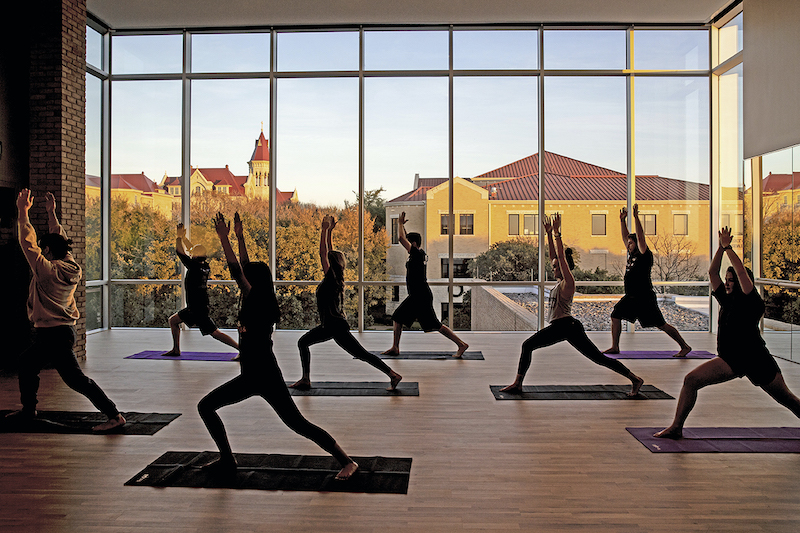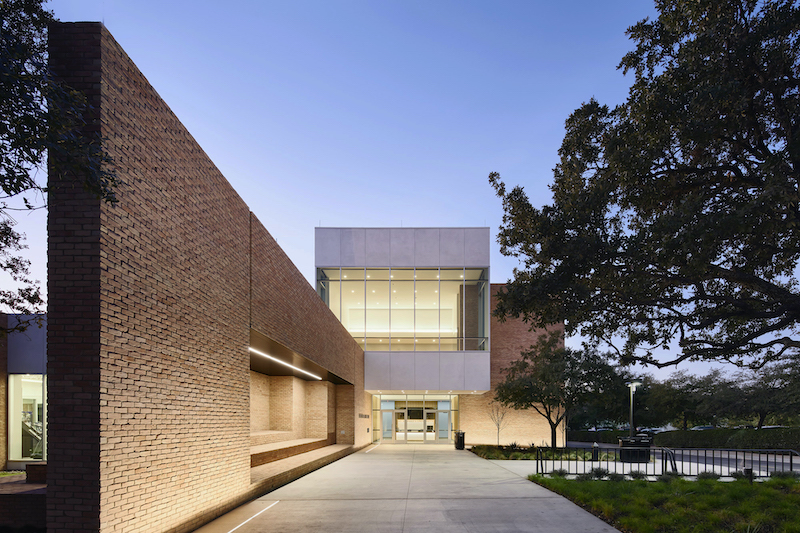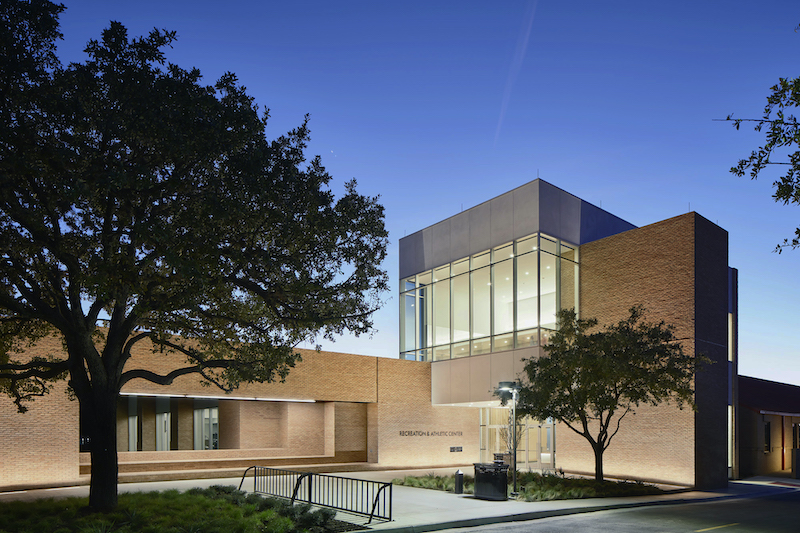The recently unveiled Recreation and Athletic Center at St. Edward’s University has been designed with a focus on holistic well-being.
The 12,400-sf addition to the existing facility, originally built in the mid 1980s, features new fitness and wellness facilities such as a yoga studio, a wellness center, and a meditation center with an openness and connection to the environment that is centered in the middle of the campus.
 Credit Andrea Calo.
Credit Andrea Calo.
The addition wraps the campus-facing side of the facility and is for use by the entire student body and faculty rather than for athletes only. A portion of the building extends out toward the heart of the campus and incorporates outdoor “stadium type” seating facing a new plaza where performance and presentation will take place. The plaza was created where a parking lot once existed and creates a new pedestrian-oriented active space.
See Also: Sacred Heart University to build $60 million hockey arena
The yoga/studio space is the focal point of the new facility and has been designed as a glass cube that floats above the entry plaza. It is located at one end of the main campus green and provides an inviting new presence at a corner of the campus that was previously dark and under-occupied.
 Credit Andrea Calo.
Credit Andrea Calo.

 Credit Andrea Calo.
Credit Andrea Calo.
 Chelsea Purgahn/St. Edward’s University ®.
Chelsea Purgahn/St. Edward’s University ®.
Related Stories
| Jun 12, 2014
Austrian university develops 'inflatable' concrete dome method
Constructing a concrete dome is a costly process, but this may change soon. A team from the Vienna University of Technology has developed a method that allows concrete domes to form with the use of air and steel cables instead of expensive, timber supporting structures.
| Jun 11, 2014
5 ways Herman Miller's new office concept rethinks the traditional workplace
Today's technologies allow us to work anywhere. So why come to an office at all? Herman Miller has an answer.
| Jun 9, 2014
6 design strategies for integrating living and learning on campus
Higher education is rapidly evolving. As we use planning and design to help our clients navigate major shifts in culture, technology, and funding, it is essential to focus on strategies that help foster an education that is relevant after graduation. One way to promote relevance is to strengthen the bond between academic disciplines and the campus residential life experience.
| May 29, 2014
7 cost-effective ways to make U.S. infrastructure more resilient
Moving critical elements to higher ground and designing for longer lifespans are just some of the ways cities and governments can make infrastructure more resilient to natural disasters and climate change, writes Richard Cavallaro, President of Skanska USA Civil.
Sponsored | | May 27, 2014
Grim Hall opens the door to fire safety with fire-rated ceramic glass
For the renovation of Lincoln University’s Grim Hall life sciences building into a state-of-the-art computer facility, Tevebaugh Associates worked to provide students and faculty with improved life safety protection. Updating the 1925-era facility's fire-rated doors was an important component of the project.
| May 20, 2014
Kinetic Architecture: New book explores innovations in active façades
The book, co-authored by Arup's Russell Fortmeyer, illustrates the various ways architects, consultants, and engineers approach energy and comfort by manipulating air, water, and light through the layers of passive and active building envelope systems.
| May 19, 2014
What can architects learn from nature’s 3.8 billion years of experience?
In a new report, HOK and Biomimicry 3.8 partnered to study how lessons from the temperate broadleaf forest biome, which houses many of the world’s largest population centers, can inform the design of the built environment.
| May 13, 2014
19 industry groups team to promote resilient planning and building materials
The industry associations, with more than 700,000 members generating almost $1 trillion in GDP, have issued a joint statement on resilience, pushing design and building solutions for disaster mitigation.
| May 11, 2014
Final call for entries: 2014 Giants 300 survey
BD+C's 2014 Giants 300 survey forms are due Wednesday, May 21. Survey results will be published in our July 2014 issue. The annual Giants 300 Report ranks the top AEC firms in commercial construction, by revenue.
| May 10, 2014
How your firm can gain an edge on university projects
Top administrators from five major universities describe how they are optimizing value on capital expenditures, financing, and design trends—and how their AEC partners can better serve them and other academic clients.

















